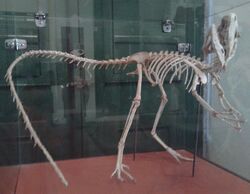Biology:Santanaraptor
| Santanaraptor | |
|---|---|

| |
| Reconstructed skeleton | |
| Scientific classification | |
| Domain: | Eukaryota |
| Kingdom: | Animalia |
| Phylum: | Chordata |
| Clade: | Dinosauria |
| Clade: | Saurischia |
| Clade: | Theropoda |
| Clade: | †Pantyrannosauria |
| Genus: | †Santanaraptor Kellner, 1999 |
| Type species | |
| †Santanaraptor placidus Kellner, 1999
| |
Santanaraptor (meaning "Santana Formation thief") is a genus of tyrannosauroid theropod dinosaur that lived in South America during the Early Cretaceous (late Aptian-early Albian), about 112 million years ago.
Discovery
The type species is S. placidus, first described by Kellner in 1999.[1] The species epithet refers to Placido Cidade Nuvens, who founded the Museu de Paleontologia da Universidade Regional do Cariri.
Description

The holotype (MN 4802-V) is a juvenile partial skeleton consisting of three caudal vertebrae with chevrons, ischia, femora, tibia, fibula, pes, and soft tissue. The fossilized tissue includes a thin epidermis,[2] muscle fibers, and possibly blood vessels.[3] Skin impressions under the left foot are also preserved, showing scales.[2] It was unearthed in 1996 from the Romualdo Formation (Santana Group) in the Ceará State, northeastern Brazil .[4] While primarily known from hindquarter elements, the individual represented by the fossil may have reached 1.5 metres (4.9 ft) in length and 15 kilograms (33 lb) in mass.[5] The fossil consists of bones from the pelvis, hindlimbs, and tail. These provide little information on its overall appearance. However, it was definitely a coelurosaur, and a few of its details suggest that it might be a member of the tyrannosauroids. It is presumed to be similar to Dilong and Guanlong in that it had long arms, three fingered hands, and slim hindlimbs.[4]
Classification
Santanaraptor was originally thought to be a maniraptoran theropod when it was first discovered. However, it is now thought to be a basal coelurosaur based on several features present on the femur. Santanaraptor was tabulated by Holtz (2004) as the first tyrannosauroid known from Gondwana,[6] a position also found by Delcourt and Grillo (2018).[7] However, this position has been criticised, as the supposed tyrannosauroid characters are widely distributed in Coelurosauria, and several aspects of the foot are more similar to noasaurids.[8]
External links
See also
References
- ↑ Kellner, A. W. A. (1999). "Short Note on a new dinosaur (Theropoda, Coelurosauria) from the Santana Formation (Romualdo Member, Albian), northeastern Brazil". Boletim do Museu Nacional (Serie Geologia) 49: 1–8.
- ↑ 2.0 2.1 Hendrickx, Christophe; Bell, Phil R.; Pittman, Michael; Milner, Andrew R. C.; Cuesta, Elena; O'Connor, Jingmai; Loewen, Mark; Currie, Philip J. et al. (2022). "Morphology and distribution of scales, dermal ossifications, and other non-feather integumentary structures in non-avialan theropod dinosaurs" (in en). Biological Reviews 97 (3): 960–1004. doi:10.1111/brv.12829. ISSN 1469-185X. PMID 34991180. https://onlinelibrary.wiley.com/doi/abs/10.1111/brv.12829.
- ↑ Kellner, A. W. A. (1996). Fossilized theropod soft tissue. Nature 379, 32. doi: https://doi.org/10.1038/379032a0
- ↑ 4.0 4.1 Benton, Michael J. (2012). Prehistoric Life. Edinburgh, Scotland: Dorling Kindersley. p. 321. ISBN 978-0-7566-9910-9.
- ↑ Paul, Gregory S. (2016). The Princeton Field Guide to Dinosaurs (2nd ed.). New Jersey: Princeton University Press. pp. 108. ISBN 978-0691167664.
- ↑ Holtz, Thomas R. Jr. (2004). "Tyrannosauroidea". The Dinosauria (Second ed.). University of California Press.
- ↑ Delcourt, Rafael; Grillo, Orlando Nelson (2018). "Tyrannosauroids from the Southern Hemisphere: Implications for biogeography, evolution, and taxonomy". Palaeogeography, Palaeoclimatology, Palaeoecology 511: 379–387. doi:10.1016/j.palaeo.2018.09.003. Bibcode: 2018PPP...511..379D.
- ↑ Doran Brownstein, Chase (2021). "Dinosaurs from the Santonian–Campanian Atlantic coastline substantiate phylogenetic signatures of vicariance in Cretaceous North America". Royal Society Open Science 8 (8): 210127. doi:10.1098/rsos.210127. PMID 34457333. Bibcode: 2021RSOS....810127D.
Wikidata ☰ Q134305 entry
 |

